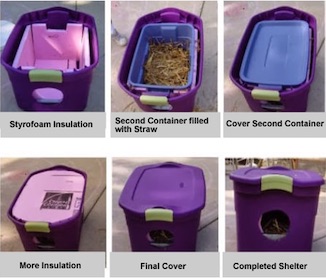
By Hali Emmons
Winter can be an especially tough time for any animals outside, but especially our domesticated canine and feline friends. If you have an outside animal or see one in need, here are some tips that can help them stay warm and safe through the coldest months of the year.
Outdoor Cats
If you have feral cats nearby or see a cat in need, an outdoor cat shelter is one of the best ways to help them. This diagram from the Alley Cat Advocate shows how easy creating an outdoor cat shelter can be.
To ensure that the shelter is properly warm, make sure to use straw. Straw is best for insulating heat for the shelter. The shelter should also be positioned on top of a small platform that would keep water or snow away from the entrance and straw should be put on the bottom of the shelter to hold heat from the outside as well.
If you are feeding outside cats, ensure the water is not frozen, food cannot be tipped over, and both are covered from the elements. A covered feeding station is a great option for monitored feeding of a colony. Always make sure to get the colony fixed! Getting the cats fixed decreases the population, helps with any behavioral issues within a colony, and tipped ears alert the community that the colony is not a threat of repopulating! If you need help getting a colony fixed, please call Cat’s Cradle at (540) 433-1135. If you can’t reach a person, leave a detailed voice message, and they will get back to you as soon as possible. They are the local contact for TNR in Page County.
Outside Dogs
Laws in the state are ever changing to help those dogs less fortunate who cannot be a part of an inside family. Animal advocates and lawmakers are working hand in hand to have more specific language added to bills for more protections for animals such as temperature guidelines and `tethering limits and absolution.
According to Virginia State Law Code§ 3.2-6500 , “adequate shelter” is defined by “provision of and access to shelter that is suitable for the species, age, condition, size, and type of each animal; provides adequate space for each animal; is safe and protects each animal from injury, rain, sleet, snow, hail, direct sunlight, the adverse effects of heat or cold, physical suffering, and impairment of health; is properly lighted; is properly cleaned; enables each animal to be clean and dry, except when detrimental to the species; during hot weather, is properly shaded and does not readily conduct heat; during cold weather, has a windbreak at its entrance and provides a quantity of bedding material consisting of straw, cedar shavings, or the equivalent that is sufficient to protect the animal from cold and promote the retention of body heat; and, for dogs and cats, provides a solid surface, resting platform, pad, floormat, or similar device that is large enough for the animal to lie on in a normal manner and can be maintained in a sanitary manner. Under this chapter, shelters whose wire, grid, or slat floors (i) permit the animals’ feet to pass through the openings, (ii) sag under the animals’ weight, or (iii) otherwise do not protect the animals’ feet or toes from injury are not adequate shelter.”
No matter how much fur your dog has, dogs are not built to live in extreme conditions. These laws help safeguard dogs from the severe conditions they are made to live in. Extra straw or shavings should be added during the coldest of days to help the dog regulate their body temperature. Snow or rain should NEVER get inside the shelter. The required windbreak will help keep out most of it, but strong, gusty winds could still blow through. A covered feeding station should make sure the water never freezes and food not tipped so the dog can make sure it can get all nutrition it needs to keep their bodies insulated. Several small meals through the day are the safest on their digestive track. If you notice a dog losing weight to where hip bones, ribs, or backbone are showing, they need more food added to their diet to make certain they are keeping a healthy weight through the winter.
If you notice something, say something. You could be the person who can change an animal’s life! Here are some local resources you can contact, even if you are not knowledgeable on animal laws, if a situation doesn’t seem safe to you.
Page County Sheriff’s Office: (540) 743-6571 (Press option #4 for dispatch, you can remain completelyanonymous)
Page Paws: (540) 244-7711 (Members of the community help with situations in Page County to ensure the safety of animals)
Dogs Deserve Better Blue Ridge: (434) 264-6170 (Assists Page Paws and members of the valley who need help with chained and/or outside dogs)



Be the first to comment